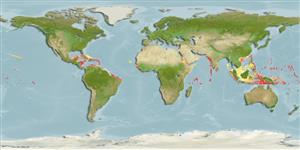Common names from other countries
>
Anguilliformes (Eels and morays) >
Muraenidae (Moray eels) > Uropterygiinae
Etymology: Channomuraena: Greek, chanos, -eos, ous, and chasma, -atos = abyss, mouth opened, inmensity + Latin, muraena = morey eel (Ref. 45335).
More on author: Richardson.
Environment: milieu / climate zone / depth range / distribution range
Ecologia
marinhas associadas(os) a recifes; intervalo de profundidade 5 - 100 m (Ref. 5217), usually 7 - 37 m (Ref. 37816). Tropical; 24°N - 11°S
Circumtropical. Indian Ocean: Reunion and Mauritius (Ref. 33390) and Christmas Island. Western Pacific: Palau, and the Hawaiian Islands. Western Atlantic: Bermuda, Bahamas, and Caribbean Sea; may occur in southern Florida, USA and northwestern Gulf of Mexico (Ref. 7251). Reported from Bahia, Brazil (Ref. 57756). Eastern Atlantic: around oceanic islands.
Tamanho / Peso / Idade
Maturity: Lm ? range ? - ? cm
Max length : 150 cm TL macho/indeterminado; (Ref. 37816); common length : 80.0 cm TL macho/indeterminado; (Ref. 5217)
Espinhos dorsais (total) : 0; Raios dorsais moles (total) : 0; Espinhos anais: 0; Raios anais moles: 0. The small cranium, anterior position of the eyes, and enlarged lower jaw are unique (Ref 1602)
A benthic species and solitary species (Ref. 26340) inhabiting outer reef slopes. Occurs under ledges and in holes of reef slopes (Ref. 37816). Has the habit of puffing its head like a cobra when approached (Ref. 37816). Secretive and nocturnal (Ref. 48635). Minimum depth reported taken from Ref. 30874.
Life cycle and mating behavior
Maturities | Reprodução | Spawnings | Egg(s) | Fecundities | Larvas
Böhlke, J.E., 1981. Muraenidae. In W. Fischer, G. Bianchi and W.B. Scott (eds.) FAO species identification sheets for fishery purposes. Eastern Central Atlantic, (Fishing Areas 34, 47 (in part)), Vol. 3. [var. pag.]. FAO, Rome. (Ref. 3254)
Categoria na Lista Vermelha da IUCN (Ref. 130435)
CITES (Ref. 128078)
Not Evaluated
Ameaça para o homem
Harmless
Utilização humana
Pescarias: pescarias de subsistência; Aquário: Espécies comerciais
Ferramentas
Relatórios especiais
Descarregue XML
Fontes da internet
Estimates based on models
Preferred temperature (Ref.
115969): 25.5 - 28.9, mean 27.7 (based on 388 cells).
Phylogenetic diversity index (Ref.
82804): PD
50 = 0.7500 [Uniqueness, from 0.5 = low to 2.0 = high].
Bayesian length-weight: a=0.00069 (0.00033 - 0.00144), b=3.12 (2.93 - 3.31), in cm Total Length, based on LWR estimates for this (Sub)family-body shape (Ref.
93245).
Nível Trófico (Ref.
69278): 4.0 ±0.66 se; based on food items.
Resiliência (Ref.
120179): Muito baixo, tempo mínimo de duplicação da população maior que 14 anos (Preliminary K or Fecundity.).
Fishing Vulnerability (Ref.
59153): Very high vulnerability (90 of 100).
